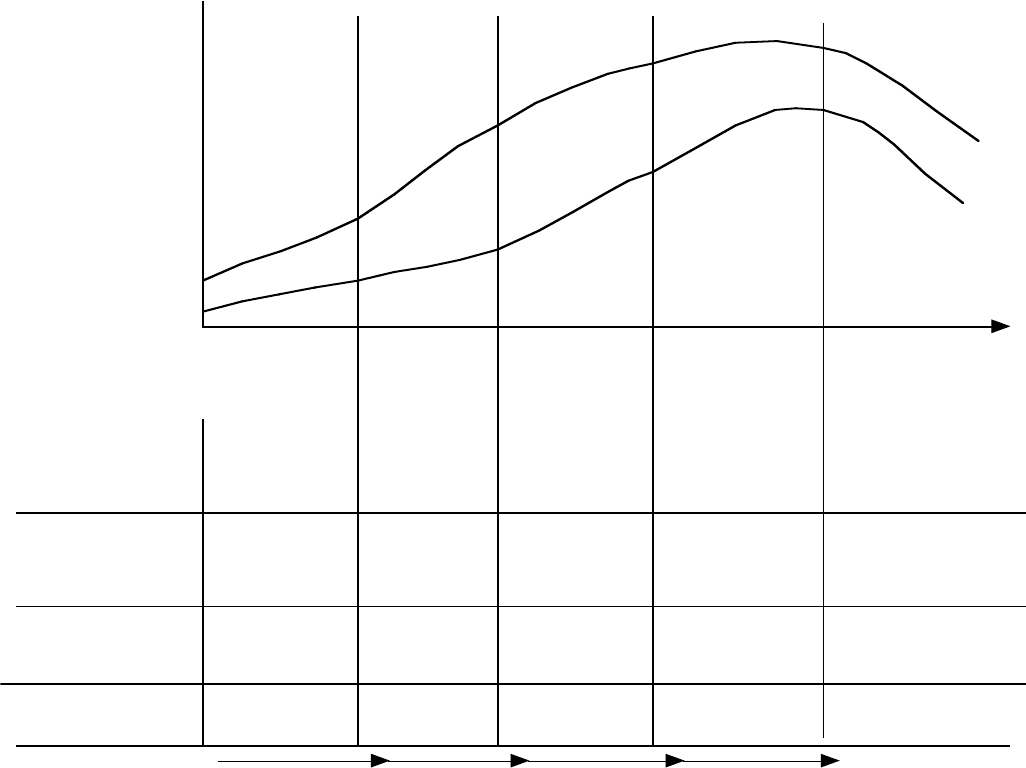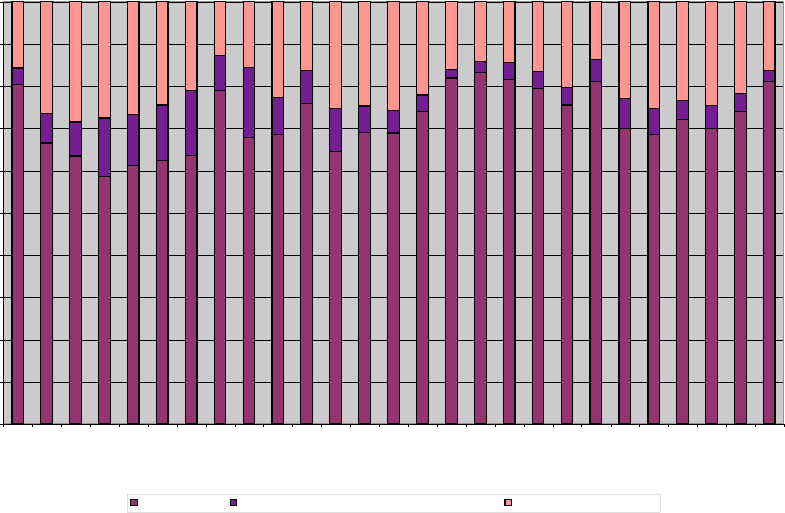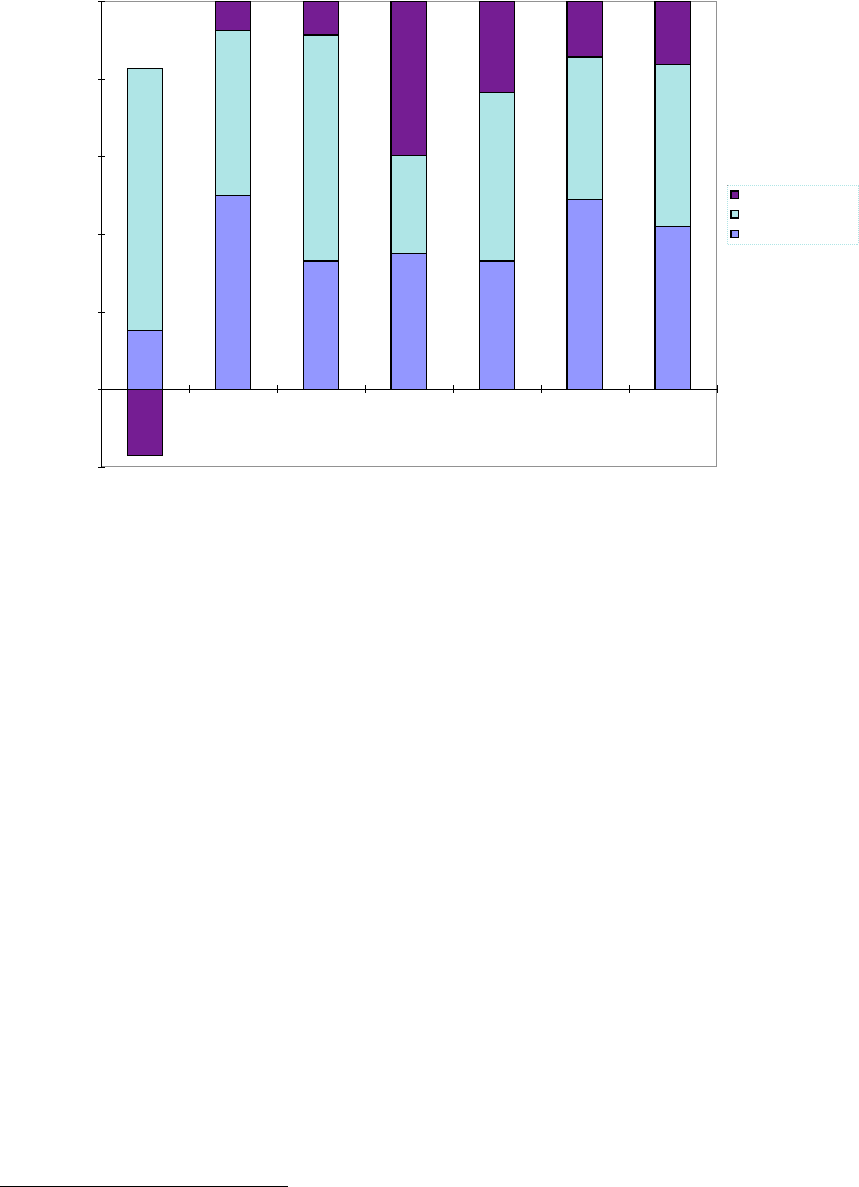Damodaran A. Applied corporate finance
Подождите немного. Документ загружается.

18
equity (or retained earnings) and external equity (new stock or equity option issues). This
equivalence implies that a project financed with internal equity should pass the same test
as a project financed with external equity; Disney has to earn a return on equity for
investors that is greater than 10% on projects funded with either external equity or
retained earnings. Second, internal equity is clearly limited to the cash flows generated
by the firm for its stockholders. Even if the firm does not pay dividends, these cash flows
may not be sufficient to finance the firm’s projects. Depending entirely upon internal
equity can therefore result in project delays or the possible loss of these projects to
competitors. Third, managers should not make the mistake of thinking that the stock price
does not matter, just because they use only internal equity for financing projects. In
reality, stockholders in firms whose stock prices have dropped are much less likely to
trust their managers to reinvest their cash flows for them than are stockholders in firms
with rising stock prices.
Growth, Risk and Financing
As firms grow and mature, their cash flows and risk exposure follow fairly
predictable patterns. Cash flows become larger, relative to firm value, and risk
approaches the average risk for all firms. The financing choices that a firm makes will
reflect these changes. To understand these choices, let us consider five stages in a firm’s
life cycle:
1. Start-up: This represents the initial stage after a business has been formed. Generally,
this business will be a private business, funded by owner’s equity and perhaps bank
debt. It will also be restricted in its funding needs, as it attempts to gain customers
and get established.
2. Expansion: Once a firm succeeds in attracting customers and establishing a presence
in the market, its funding needs increase as it looks to expand. Since this firm is
unlikely to be generating high cash flows internally at this stage and investment needs
will be high, the owners will generally look to private equity or venture capital
initially to fill the gap. Some firms in this position will make the transition to publicly
traded firms and raise the funds they need by issuing common stock.
19
3. High Growth: With the transition to a publicly traded firm, financing choices
increase. While the firm’s revenues are growing rapidly, earnings are likely to lag
behind revenues, and internal cash flows lag behind reinvestment needs. Generally,
publicly traded firms at this stage will look to more equity issues, in the form of
common stock, warrants and other equity options. If they are using debt, convertible
debt is most likely to be used to raise capital.
4. Mature Growth: As growth starts leveling off, firms will generally find two
phenomena occurring. The earnings and cash flows will continue to increase rapidly,
reflecting past investments, and the need to invest in new projects will decline. The
net effect will be an increase in the proportion of funding needs covered by internal
financing, and a change in the type of external financing used. These firms will be
more likely to use debt in the form of bank debt or corporate bonds to finance their
investment needs.
5. Decline: The last stage in this life cycle is decline. Firms in this stage will find both
revenues and earnings starting to decline, as their businesses mature and new
competitors overtake them. Existing investments are likely to continue to produce
cash flows, albeit at a declining pace, and the firm has little need for new investments.
Thus, internal financing is likely to exceed reinvestment needs. Firms are unlikely to
be making fresh stock or bond issues, but are more likely to be retiring existing debt
and buying back stock. In a sense, the firm is gradually liquidating itself.
Figure 7.2 summarizes both the internal financing capabilities and external financing
choices of firms at different stages in the growth life cycle.
Not all firms go through these five phases, and the choices are not the same for all of
them. First, many firms never make it past the start-up stage in this process. Of the tens
of thousands of businesses that are started each year by entrepreneurs, many fail to
survive, and even those that survive often continue as small businesses with little
expansion potential. Second, not all successful private firms become publicly traded
corporations. Some firms, like Cargill and Koch Industries, remain private and manage to
raise enough capital to continue growing at healthy rates over long periods. Thirdly, there
are firms like Microsoft that are in high growth and seem to have no need for external
financing, as internal funds prove more than sufficient to finance this growth. There are
20
high growth firms that issue debt, and low growth firms that raise equity capital. In short,
there are numerous exceptions, but the life cycle framework still provides a useful device
to explain why different kinds of firms do what they do, and what causes them to deviate
from the prescribed financing choices.
Note that while we look at a firm’s choices in terms of debt and equity at different
stages in the growth life cycle, there are two things we do not do in this analysis. First,
we do not explain in any detail why firms at each stage in the growth life cycle pick the
types of financing that they do. Second, we do not consider what kind of debt is best for a
firm – short term or long term, dollar or foreign currency, fixed rate or floating rate. The
reason is that this choice has more to do with the types of assets the firm owns and the
nature of the cash flows from these assets, than with where in its life cycle a firm is in.
We will return to examine this issue in more detail in chapter 9.

21
Stage 2
Rapid Expansion
Stage 1
Start-up
Stage 4
Mature Growth
Stage 5
Decline
Figure 7.2: Life Cycle Analysis of Financing
External
Financing
Revenues
Earnings
Owner’s Equity
Bank Debt
Venture Capital
Common Stock
Debt
Retire debt
Repurchase stock
External funding
needs
High, but
constrained by
infrastructure
High, relative
to firm value.
Moderate, relative
to firm value.
Declining, as a
percent of firm
value
Internal financing
Low, as projects dry
up.
Common stock
Warrants
Convertibles
Stage 3
High Growth
Negative or
low
Negative or
low
Low, relative to
funding needs
High, relative to
funding needs
More than funding needs
Accessing private equity
Inital Public offering
Seasoned equity issue
Bond issues
Financing
Transitions
Growth stage
$ Revenues/
Earnings
Time

22
22
How Firms have Actually Raised Funds
In the first part of this chapter, we noted the range of choices in terms of both debt
and equity that are available to firms to raise funds. Before we look at which of these
choices firms should use, it is worth noting how firms have historically raised funds for
operations. While firms have used debt, equity and hybrids to raise funds, their
dependence on each source has varied across time. In the United States, for instance,
firms have generally raised external financing through debt issues rather than equity
issues, and have primarily raised equity funds internally from operations. Figure 7.3
illustrates the proportion of funds from new debt and equity issues, as well as from
internal funds, for U.S. corporations between 1975 and 2001.
Figure 7.3: External and Internal Financing at US Firms
0%
10%
20%
30%
40%
50%
60%
70%
80%
90%
100%
1975
1976
1977
1978
1979
1980
1981
1982
1983
1984
1985
1986
1987
1988
1989
1990
1991
1992
1993
1994
1995
1996
1997
1998
1999
2000
2001
Year
Internal Financing External Financing from Common and Preferred Stock External Financing from Debt
Source: Compustat
In every year, firms have relied more heavily on internal financing to meet capital needs
than on external financing. Furthermore, when external financing is used, it is more likely
to be new debt rather than new equity or preferred stock.

23
23
There are wide differences across firms in the United States in how much and
what type of external financing they use. The evidence is largely consistent with the
conclusions that emerge from looking at a firm’s place in the growth cycle in Figure 7.2.
Fluck, Holtz-Eakin and Rosen (1998) looked at several thousand firms that were
incorporated in Wisconsin
2
; most of these firms were small, private businesses. The
authors find that these firms depend almost entirely on internal financing, owner’s equity
and bank debt to cover their capital needs. The proportion of funds provided by internal
financing increases as the firms became older and more established. A small proportion
of private businesses manage to raise capital from venture capitalists and private equity
investors. Many of these firms plan on ultimately going public, and the returns to the
private equity investors come at the time of the public offering. Bradford and Smith
(1997) looked at 60 computer-related firms prior to their initial public offerings and noted
that 41 of these firms had private equity infusions before the public offering. The median
number of private equity investors in these firms was between two and three, and the
median proportion of the firm owned by these investors was 43.8%; an average of 3.2
years elapsed between the private equity investment and the initial public offering at
these firms. While this is a small sample of firms in one sector, it does suggest that
private equity plays a substantial role in allowing firms to bridge the gap between private
businesses and publicly traded firms.
In comparing the financing patterns of U.S. companies to companies in other
countries, we find some evidence that U.S. companies are much more heavily dependent
upon debt than equity for external financing than their counterparts in other countries.
Figure 7.4 summarizes new security issues
3
in the G-7 countries
4
between 1984 to 1991–
2
This is a unique data set, since this information is usually either not collected or not available to
researchers.
3
This is based upon OECD data, summarized in the OECD publication “ Financial Statements of Non-
Financial Enterprises”. This data is excerpted from Rajan and Zingales (1995).
4
The G-7 countries represent seven of the largest economies in the world. The leaders of these countries
meet every year to discuss economic policy.

24
24
Source: OECD
Net equity, in this graph, refers to the difference between new equity issues and stock
buybacks. Firms in the United States, during the period of this comparison, bought back
more stock than they issued, leading to negative net equity. In addition, a comparison of
financing patterns in the United States, Germany and Japan reveals that German and
Japanese firms are much more dependent upon bank debt than firms in the United States,
which are much likely to issue bonds.
5
Figure 7.5 provides a comparison of bank loans
and bonds as sources of debt for firms in the three countries, as reported in Hackethal and
Schmidt (1999).
5
Hackethal and Schmidt (1999) compare financing patterns in the three countries.
Figure 7.4: Financing Patterns for G-7 Countries – 1984-91
-20%
0%
20%
40%
60%
80%
100%
United States Japan Germany France Italy United
Kingdom
Canada
Country
Financing Mix
Net Equity
Net Debt
Internal Financing

25
25
Figure 7.5: Bonds versus Bank Loans - 1990-96
0%
20%
40%
60%
80%
100%
120%
140%
160%
180%
United States Japan Germany
% of Physical Investment
Bank & Other Loans
Bonds & Commercial paper
Source: Hackethal and Schmidt (1999)
There is also some evidence that firms in some emerging markets, such as Brazil
and India, use equity (internal and equity) much more than debt to finance their
operations. Some of this dependence can be attributed to government regulation that
discourages the use of debt, either directly by requiring the debt ratios of firms to be
below specified limits or indirectly by limiting the deductibility of interest expenses for
tax purposes. One of the explanations for the greater dependence of U.S. corporations on
debt issues relies on where they are in their growth life cycle. Firms in the United States,
in contrast to firms in emerging markets, are much more likely to be in the mature growth
stage of the life cycle. Consequently, firms in the US should be less dependent upon
external equity. Another factor is that firms in the United States have far more access to
corporate bond markets than do firms in other markets. Firms in Europe, for instance,
often have to raise new debt from banks, rather than bond markets. This may constrain
them in the use of new debt.
7.8. ☞: Corporate Bond Markets and the use of debt

26
26
Companies in Europe and emerging markets have historically depended upon bank debt
to borrow and have had limited access to corporate bond markets. In recent years, their
access to corporate bond markets, both domestically and internationally, has increased.
As a result, which of the following would you expect to happen to debt ratios in these
countries?
a. Debt ratios should go up
b. Debt ratios should go down
c. Debt ratios should not change much
finUS.xls: There is a dataset on the web that has aggregate internal and external
financing, for US firms, from 1975 to 1998.
The Process of Raising Capital
Looking back at figure 7.2, we note four financing transitions, where the source of
funding for a firm is changed by the introduction of a new financing choice. The first
occurs when a private firm approaches a private equity investor or venture capitalist for
new financing. The second occurs when a private firm decides to offer its equity to
financial markets and become a publicly traded firm. The third takes place when a
publicly traded firm decides to revisit equity markets to raise more equity. The fourth
occurs when a publicly traded firms decides to raise debt from financial markets by
issuing bonds. In this section, we examine the process of making each of these
transitions. Since the processes for making seasoned equity and bond issues are very
similar, we will consider them together.
Private Firm Expansion: Raising Funds from Private Equity
Private firms that need more equity capital than can be provided by their owners
can approach venture capitalists and private equity investors. Venture capital can prove
useful at different stages of a private firm’s existence. Seed-money venture capital, for
instance, is provided to start-up firms that want to test a concept or develop a new

27
27
product, while start-up venture capital allows firms that have established products and
concepts to develop and market them. Additional rounds of venture capital allow private
firms that have more established products and markets to expand. There are five steps
associated with how venture capital gets to be provided to firms, and how venture
capitalists ultimately profit from these investments.
1. Provoke equity investor’s interest: The first step that a private firm wanting to raise
private equity has to take is to get private equity investors interested in investing in it.
There are a number of factors that help the private firm, at this stage. One is the type
of business that the private firm is in, and how attractive this business is to private
equity investors. The second factor is the track record of the top manager or managers
of the firm. Top managers, who have a track record of converting private businesses
into publicly traded firms, have an easier time raising private equity capital.
2. Valuation and Return Assessment: Once private equity investors become interested in
investing in a firm, the value of the private firm has to be assessed by looking at both
its current and expected prospects. This is usually done using the venture capital
method, where the earnings of the private firm are forecast in a future year, when the
company can be expected to go public. These earnings, in conjunction with a price-
earnings multiple, estimated by looking at publicly traded firms in the same business,
is used to assess the value of the firm at the time of the initial public offering; this is
called the exit or terminal value.
For instance, assume that Bookscape is expected to have an initial public offering
in 3 years, and that the net income in three years for the firm is expected to be $ 4
million. If the price-earnings ratio of publicly traded retail firms is 25, this would
yield an estimated exit value of $ 100 million. This value is discounted back to the
present at what venture capitalists call a target rate of return, which measures what
venture capitalists believe is a justifiable return, given the risk that they are exposed
to. This target rate of return is usually set at a much higher level
6
than the traditional
cost of equity for the firm.
Discounted Terminal Value = Estimated exit value /(1+ Target return)
n
6
By 1999, for instance, the target rate of return for private equity investors was in excess of 30%.
